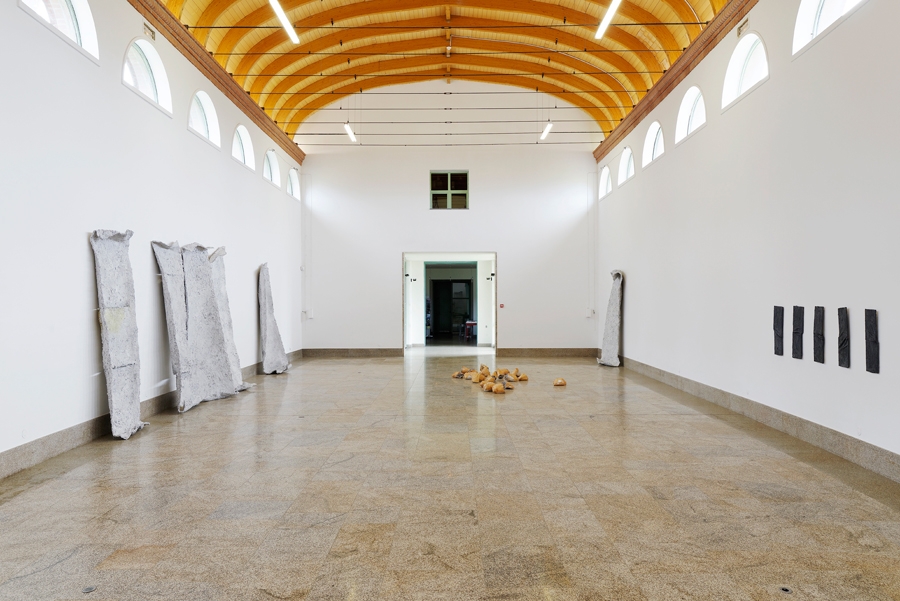20 March – 12 June 2016, Centre International d’Art et du Paysage, Île de Vassivière
As much as the Centre International d’Art et du Paysage is a unique place to visit, it is a tricky venue in which to exhibit. Its natural context – an island on a lake, surrounded solely by nature – seems idyllic and untouched until you discover that it underwent a defining trauma: formed from the damming of the river in 1950, the lake submerged multiple hamlets in its creation. The centre’s other major trait is, well, its own architecture. Built in 1991 by Aldo Rossi and Xavier Fabre, the authoritative, industrial-looking building consists of a 20m-high conical lighthouse structure and a rectilinear gallery (including a large nave and three smaller rooms) that unfolds lengthways down the slope, pointing at the dam. (A line of semicircular windows runs along the building’s length, echoing the structure of an aqueduct.) Another rupture within the natural landscape, its monumental interior spaces make it a challenge for any artist. In this context, and in its quietude, the work of British artist Lydia Gifford – whose textural abstraction bears affinities to American abstraction by the likes of Eva Hesse and Robert Ryman – might have seemed an even riskier match. Yet, by resisting strategies of confrontation or takeover of the space (which Gifford’s predecessor here, Reto Pulfer, sought to conceal underneath vast textile tents), her sculptures subtly assert their presence by reinstating a human and natural order that resonates quite poignantly and poetically within and beyond the walls.
The works presented in the long nave, lit by the windows placed loftily in the seven-metre-high walls, seem to defuse the building’s authority through their antimonumental and vulnerable presence. Six grey, two-metre-high sculptures reminiscent of rolled-out and creased parchment lean precariously against the walls, distributed unevenly along their length as if describing a score (Peel 1–7, all works 2016). Made of paper pulp conglomerated with gesso and other materials, their crumbly presence seems frail and almost endangered by the rigidity of the space, while some 20 round, spongelike sculptures with mineral tones and texture, titled Siphons, are scattered in the middle of the marbled floor, as if striving to filter through the soil underground.
Further, amidst the redbrick walls and columns of the former ‘atelier’ space, are six airy white sculptures held on steel rods, forming a small forest in which to circulate. The fusion of the materials (the folding, melding and permeating of cardboard, cotton, gesso, oil paint and kaolin slip) and their organic tactility against the raw elements of the setting conjures up at once the ephemerality and resilience of human nature, also evoked by the 1961 Sylvia Plath poem after which the show was titled (‘Compared with me, a tree is immortal / And a flower-head not tall, but more startling / And I want the one’s longevity and the other’s daring’).
The connection with the natural landscape deepens as you ascend into the bright upper rooms, where the rows of windows are finally at eye level. The works here sharpen the focus around the line, seen as a structural component of architecture, landscape and art; works on paper, hung in line with the windows, experiment with delicate overlays of earthy colours, textures and densities, while curved bits of steel have been bent and arranged on the floor to describe a circle. In the final room, it’s the tension between horizontality and verticality that dominates, striking an equilibrium between the concrete-saturated cloth sculptures on the floor (Vassal 1–3) and a diptych of cotton soaked with paint and gesso that has been contorted, stretched and fixed onto wooden boards with nails (Level). A level line seems to traverse both reliefs, which stand separated by a small square window; as you gaze through it, you discern the line of the dam on the horizon, as the ultimate hyphenation – for want of a full stop.
This article was first published in the May 2016 issue of ArtReview.
